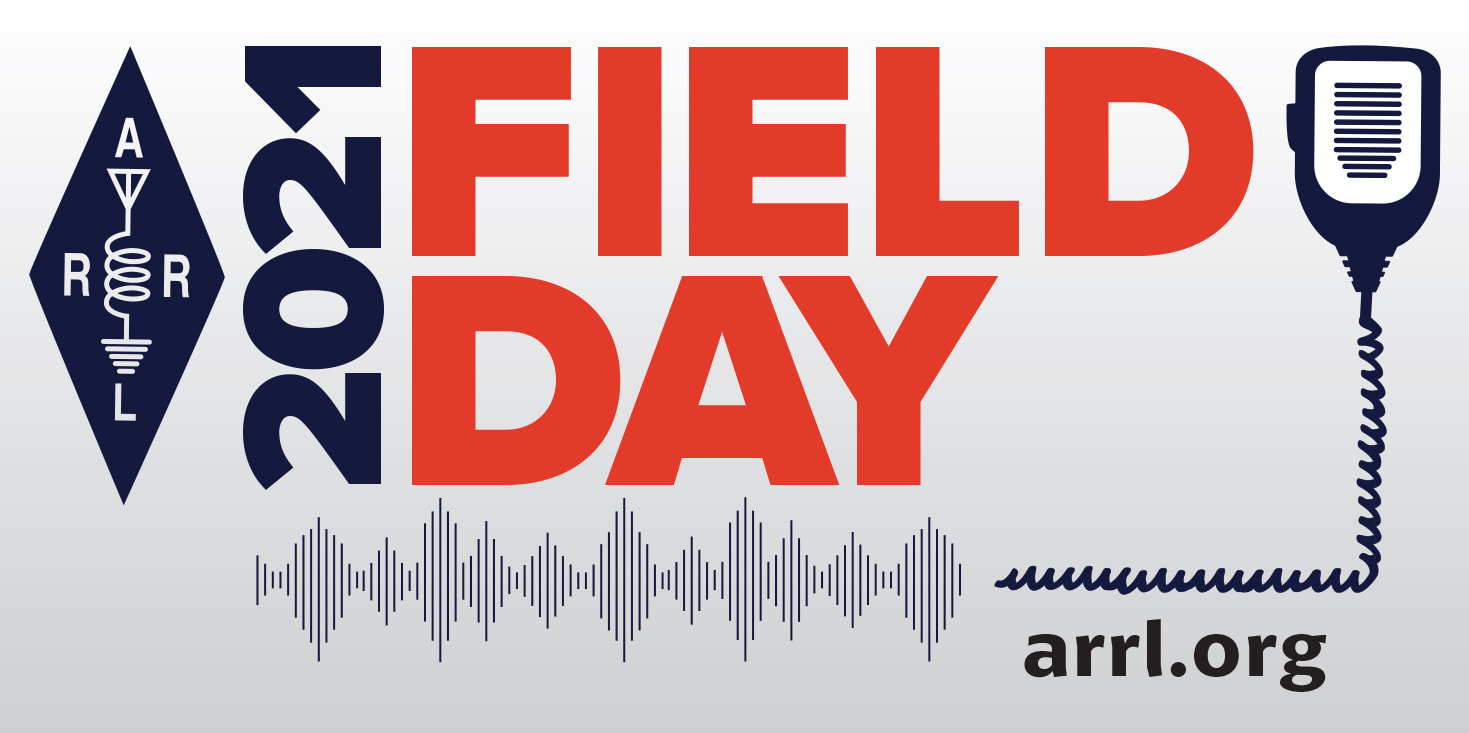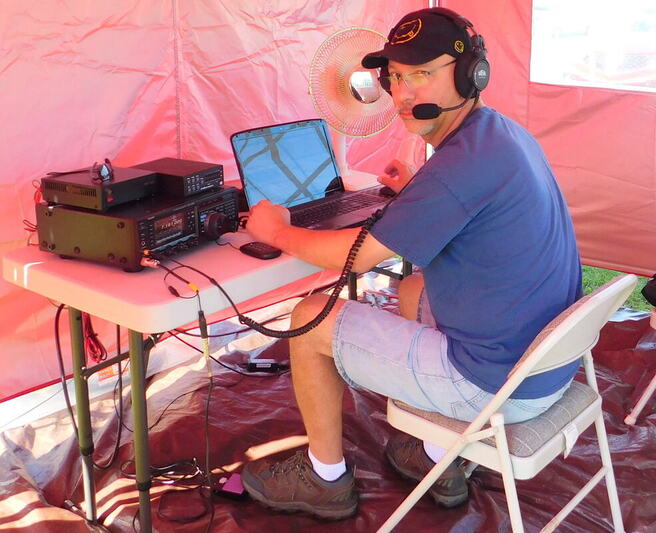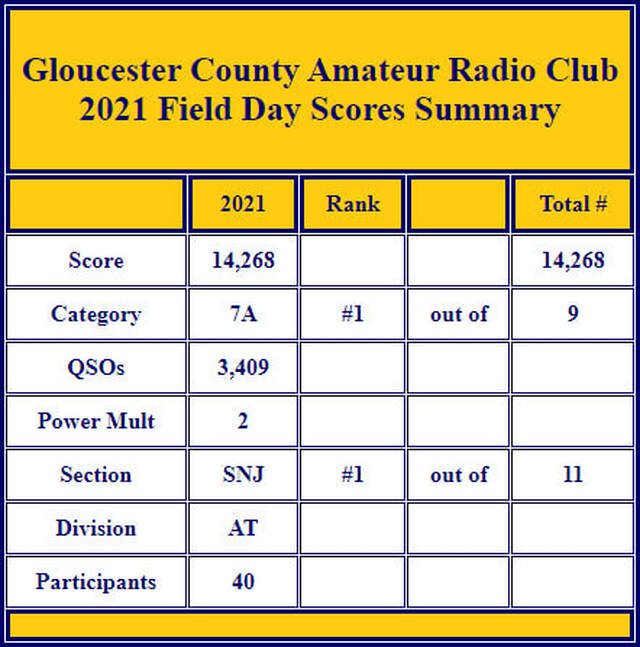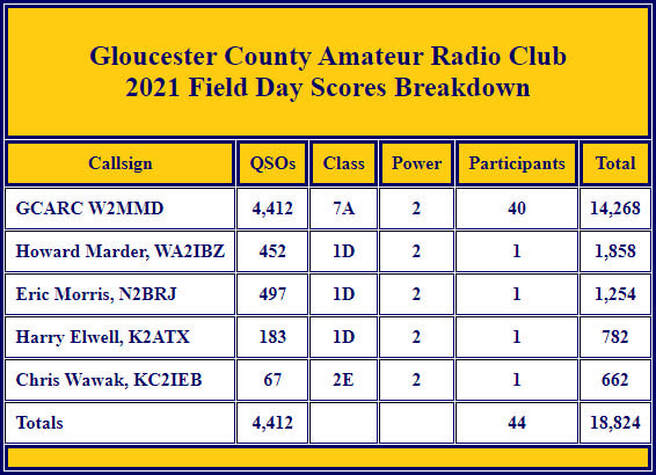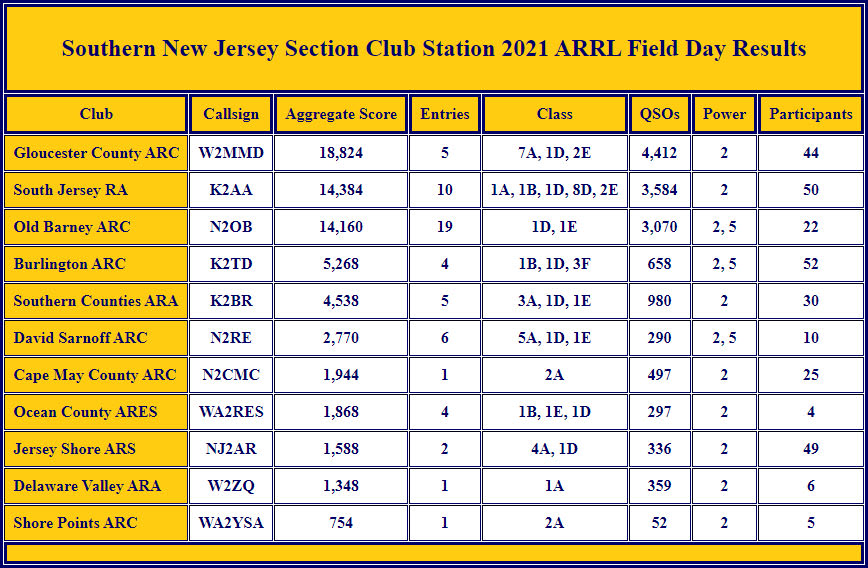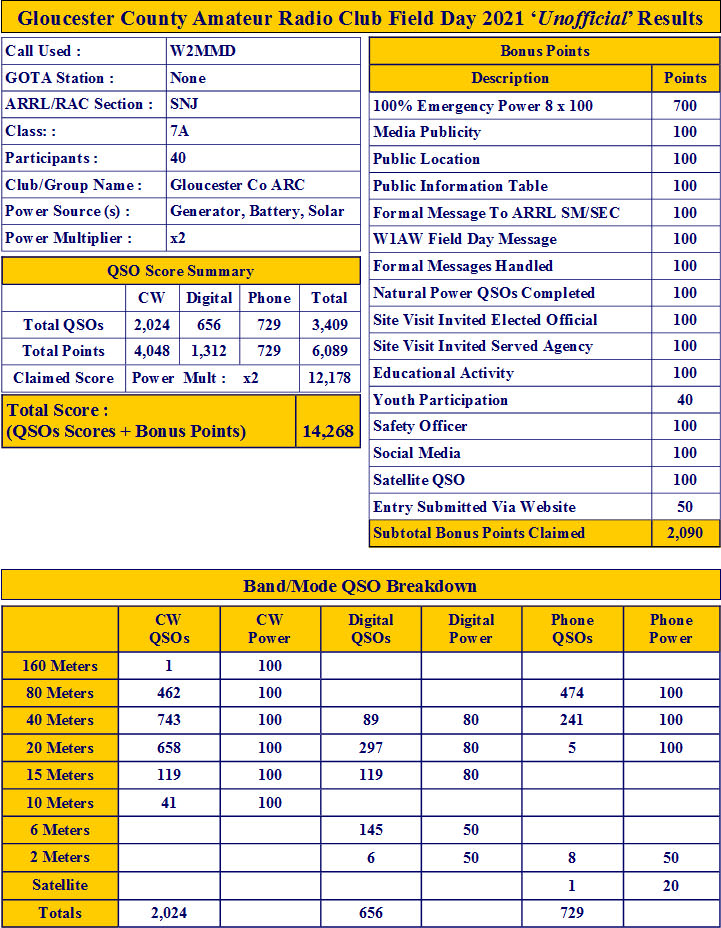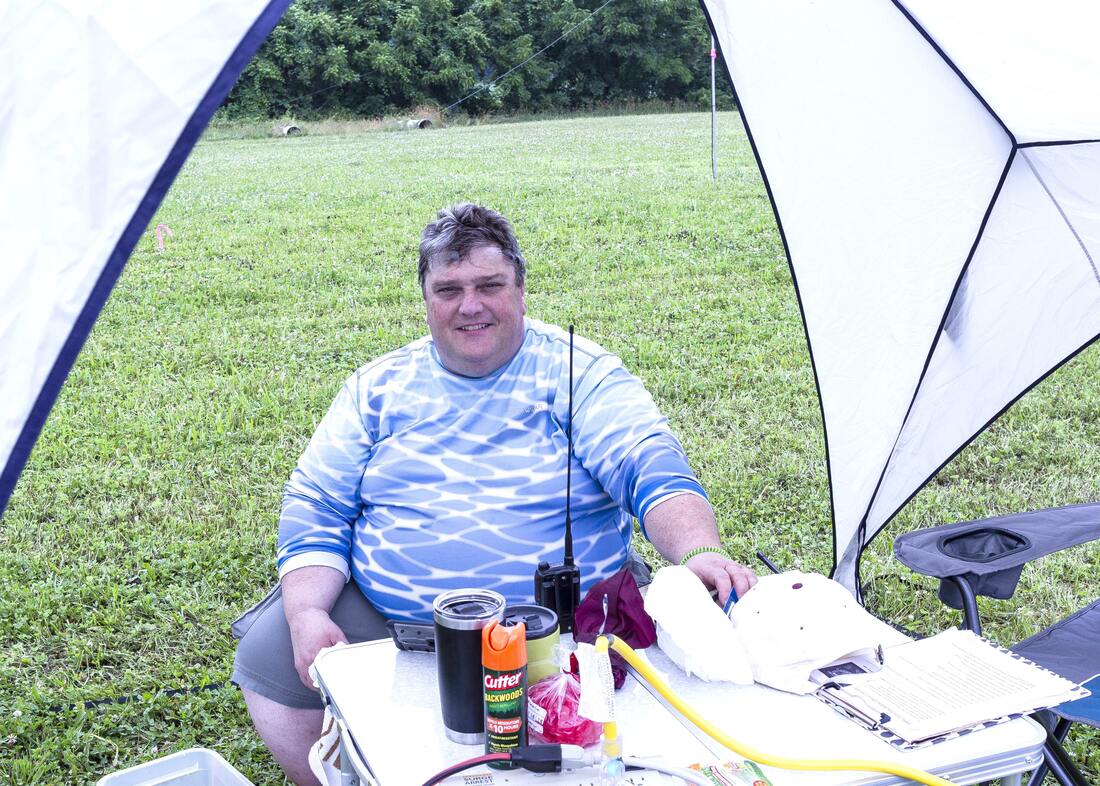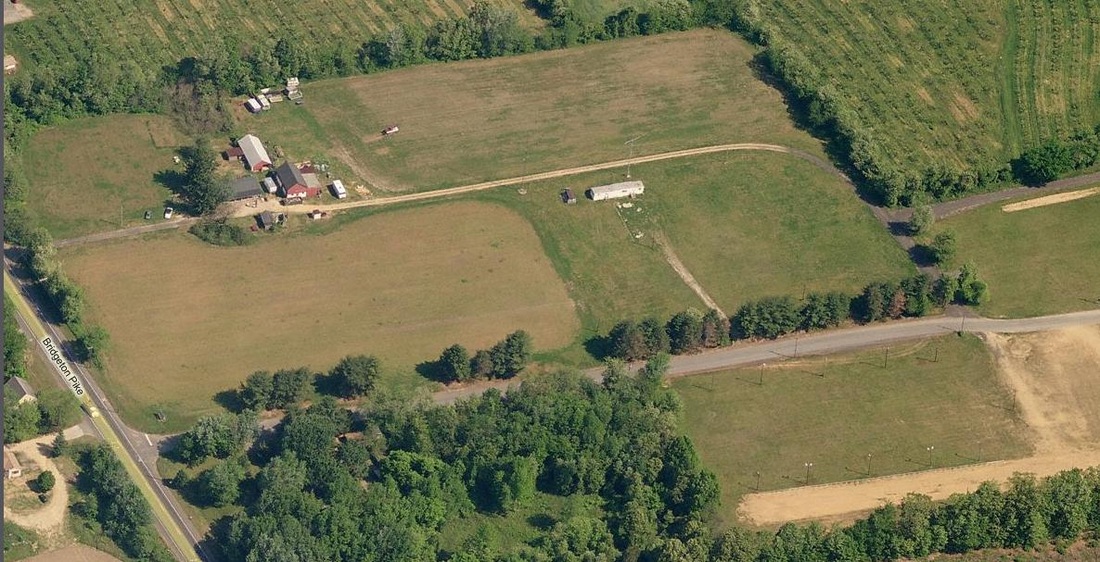Satellite DX Confirmed QSL Cards
The GCARC Field Day Satellite Station 2021
By Jon Pearce, WB2MNF
Field Day is always an important event for the GCARC Skunkworks team. A single satellite QSO is worth 100 bonus points - more points than some single-band stations get throughout the entire contest - and everyone in the Club knows whether we’ve succeeded or failed at getting that QSO. And the satellite station needs to be fully-functional - we need the best antennas that we can get along with an azimuth-elevation rotation system that will track satellites as they move across the sky. During Field Day satellite signals are far weaker than at other times because the power budget of the satellite is fixed and gets distributed among all stations. Normally when only a few stations are using a satellite each station gets a significant portion of that budget with a commensurate signal strength level, but on Field Day a dozen stations may be vying for those watts with a resulting decrease in the level of each signal.
In earlier years we used the “Armstrong” method of antenna rotation with volunteers aiming the Arrow portable antennas at the satellite, and although we were always successful at making at least one contact this process was clearly suboptimal. Last year we had obtained the M2 “LEO Pack” of crossed yagi antennas for 2 meters and 70 cm but using the Portable Rotation rotator (which has since been discontinued) didn’t work very well - it had a tendency to wrap the feedlines around the mast if not carefully supervised during a pass, and it also seemed to lose calibration easily.
This year Frank N3PUU decided to build the V3 az/el rotator (https://wiki.satnogs.org/SatNOGS_Rotator_v3) developed by the SatNOGS team that also manages the satellite telemetry tracking network. This uses stepper motors as the basic motor and creates antenna rotation through a large set of 3D printed gears. Over the past year Frank printed and assembled the rotator and he, John K2QA and I took it down to the W2MMD Clubhouse for testing a couple of weeks before Field Day.
Those tests were disappointing. While the azimuth rotator was able to rotate the antenna array around the horizontal axis the elevation rotator didn’t have enough torque to elevate the antennas. At that point the antennas hadn’t been balanced - each was mounted at the recommended mounting point that created more weight on the front of the antenna array than on the back. Additional technical issues occurred at that point so we had to abandon that effort with Frank planning to do additional testing to ascertain the problem with the elevation rotation.
The following Saturday we reconvened, Frank having checked all of the motors and other components and verifying that they worked properly. It appears that the SatNOGS design didn’t provide for motors having enough torque to rotate the complete LEO Pack antenna setup. However, we still believed that with proper balancing of antennas we could still get the elevation rotator to work, and we were finally successful after tying the feedlines back up the antenna masts to the boom, remounting both antennas closer to the balance point and adding some small weights by tie-wrapping washers to the end of the antenna. All of this may have affected the RF pattern but it was necessary to make the elevation rotator functional. We did find that the rotator would lock up when rotating at about 80 degrees of elevation (which is strange because higher elevations should require less motor torque) which we solved by locking the maximum elevation in the PST Rotator controller program at 75 degrees. This solved the rotation issue.
We also had experienced interference on the 70 cm downlink frequency from the 2 meter uplink signal (satellite operation is cross-band and full-duplex). This was solved with a diplexer that split the 2 meter and 70 cm signals and fed the 2 meter signal into a dummy load while passing the 70 cm signal through to the receiver. We used a SDR Play radio and the SDR Console program for the downlink and an IC-7100 for the uplink.
Other important station components were a multi-port headphone amplifier that allowed multiple operators to listen to the received signal and vary their own volume levels - this was especially critical because of a large noisy event occurring in the field next to the Clubhouse. A secondary display on my Dell laptop allowed viewing the PST Rotator screens showing the satellite and rotator positioning as well as upcoming satellite passes on one screen with the SDR display on the other. My Honda 2200 inverter generator loafed along providing power for the weekend.
Greg W5DO and I made a few test contacts before the 2 PM Field Day start time to be sure that everything was working. Once the event started we had to wait until the next satellite pass and in the second group of passes around 5 PM we made our “bonus” contact on AO-7, the oldest of the ham radio satellites still in operation. After that we tried working several other passes but found that the FT-8 station on 6 meters would clobber our reception at unpredictable times. We also found that signal strength was quite weak - much weaker than we found at the Clubhouse satellite station during the same period. This made us suspect that the RG-58 feedline that we were using was the cause, so a goal for next year is to either replace that feedline or install a preamp near the antenna. These issues combined together caused us to conclude that getting the first bonus contact was worth the effort but getting additional contacts was not, so we shut down the satellite station around 9 PM.
Overall the project was a success - we maintained our record of getting the satellite bonus contact each year that we attempted it, and had no major hardware or operating failures once we got everything working. Our goal for next year will be to improve the receive signal strength to make contacts easier, and to continue our previous successes.
By Jon Pearce, WB2MNF
Field Day is always an important event for the GCARC Skunkworks team. A single satellite QSO is worth 100 bonus points - more points than some single-band stations get throughout the entire contest - and everyone in the Club knows whether we’ve succeeded or failed at getting that QSO. And the satellite station needs to be fully-functional - we need the best antennas that we can get along with an azimuth-elevation rotation system that will track satellites as they move across the sky. During Field Day satellite signals are far weaker than at other times because the power budget of the satellite is fixed and gets distributed among all stations. Normally when only a few stations are using a satellite each station gets a significant portion of that budget with a commensurate signal strength level, but on Field Day a dozen stations may be vying for those watts with a resulting decrease in the level of each signal.
In earlier years we used the “Armstrong” method of antenna rotation with volunteers aiming the Arrow portable antennas at the satellite, and although we were always successful at making at least one contact this process was clearly suboptimal. Last year we had obtained the M2 “LEO Pack” of crossed yagi antennas for 2 meters and 70 cm but using the Portable Rotation rotator (which has since been discontinued) didn’t work very well - it had a tendency to wrap the feedlines around the mast if not carefully supervised during a pass, and it also seemed to lose calibration easily.
This year Frank N3PUU decided to build the V3 az/el rotator (https://wiki.satnogs.org/SatNOGS_Rotator_v3) developed by the SatNOGS team that also manages the satellite telemetry tracking network. This uses stepper motors as the basic motor and creates antenna rotation through a large set of 3D printed gears. Over the past year Frank printed and assembled the rotator and he, John K2QA and I took it down to the W2MMD Clubhouse for testing a couple of weeks before Field Day.
Those tests were disappointing. While the azimuth rotator was able to rotate the antenna array around the horizontal axis the elevation rotator didn’t have enough torque to elevate the antennas. At that point the antennas hadn’t been balanced - each was mounted at the recommended mounting point that created more weight on the front of the antenna array than on the back. Additional technical issues occurred at that point so we had to abandon that effort with Frank planning to do additional testing to ascertain the problem with the elevation rotation.
The following Saturday we reconvened, Frank having checked all of the motors and other components and verifying that they worked properly. It appears that the SatNOGS design didn’t provide for motors having enough torque to rotate the complete LEO Pack antenna setup. However, we still believed that with proper balancing of antennas we could still get the elevation rotator to work, and we were finally successful after tying the feedlines back up the antenna masts to the boom, remounting both antennas closer to the balance point and adding some small weights by tie-wrapping washers to the end of the antenna. All of this may have affected the RF pattern but it was necessary to make the elevation rotator functional. We did find that the rotator would lock up when rotating at about 80 degrees of elevation (which is strange because higher elevations should require less motor torque) which we solved by locking the maximum elevation in the PST Rotator controller program at 75 degrees. This solved the rotation issue.
We also had experienced interference on the 70 cm downlink frequency from the 2 meter uplink signal (satellite operation is cross-band and full-duplex). This was solved with a diplexer that split the 2 meter and 70 cm signals and fed the 2 meter signal into a dummy load while passing the 70 cm signal through to the receiver. We used a SDR Play radio and the SDR Console program for the downlink and an IC-7100 for the uplink.
Other important station components were a multi-port headphone amplifier that allowed multiple operators to listen to the received signal and vary their own volume levels - this was especially critical because of a large noisy event occurring in the field next to the Clubhouse. A secondary display on my Dell laptop allowed viewing the PST Rotator screens showing the satellite and rotator positioning as well as upcoming satellite passes on one screen with the SDR display on the other. My Honda 2200 inverter generator loafed along providing power for the weekend.
Greg W5DO and I made a few test contacts before the 2 PM Field Day start time to be sure that everything was working. Once the event started we had to wait until the next satellite pass and in the second group of passes around 5 PM we made our “bonus” contact on AO-7, the oldest of the ham radio satellites still in operation. After that we tried working several other passes but found that the FT-8 station on 6 meters would clobber our reception at unpredictable times. We also found that signal strength was quite weak - much weaker than we found at the Clubhouse satellite station during the same period. This made us suspect that the RG-58 feedline that we were using was the cause, so a goal for next year is to either replace that feedline or install a preamp near the antenna. These issues combined together caused us to conclude that getting the first bonus contact was worth the effort but getting additional contacts was not, so we shut down the satellite station around 9 PM.
Overall the project was a success - we maintained our record of getting the satellite bonus contact each year that we attempted it, and had no major hardware or operating failures once we got everything working. Our goal for next year will be to improve the receive signal strength to make contacts easier, and to continue our previous successes.
Field Day - June 26 - 27, 2021 |
||
|---|---|---|
| Band | Operator | Mode |
Harry Elwell, K2ATX |
||
Ken Denson, WB2P Herb Dyer, KT2Y |
||
Sheldon Parker, K2MEN Gene Schoeberlein, AA2YO Dennis Sandole, K2SE |
||
Sheldon Parker, K2MEN |
||
Harry Elwell, K2ATX |
||
(Get On The Air) Station |
100 Points Max |
Field Day Chairman - Vinnie Sallustio, N4NYY yankees_1996(at)hotmail(dot)com Chart updated as of March 31, 2021 |
Field Day - June 26 - 27, 2021 |
||
|---|---|---|
4-H Fairgrounds |
Points |
|
Checklist |
Points |
|
Table |
Points |
|
Staff |
Karl Frank, W2KBF |
|
Electronic Logs |
Points |
|
/Transmitter |
||
Generator |
/Transmitter |
|
Power |
Points |
|
Activity |
Points |
|
Participation |
100 Points Max |
|
Points |
||
Points |
||
To Section Manager |
Points |
|
Day Message |
Points |
|
Message Handling |
100 Points Max |
|
Elected Official |
Points |
|
Served Agency Official |
Points |
|
Points |
Field Day Chairman - Vinnie Sallustio, N4NYY yankees_1996(at)hotmail(dot)com Chart updated as of March 31, 2021 |
When I got my tech ticket in Jan 2017, I bought a inexpensive HT and I thought : what next? I got an invite to a GCARC Club meeting by then Prez Harry, and took him up on the offer. After the meeting, I plunked down my dues and joined the Club if only to have the opportunity to figure out what in the heck they were talking about. (I come from IT, not electronics). Seemed like a nice enough bunch but they surely were talking a different language.
After the slow drip of radio info for several months online, it was not until June 2017 where this dry sponge got caught in front of a fire hose of Ham tech, i.e. Field Day. My other hobby is motorcycle camping, I got the idea of turning FD into a camping trip at the Clubhouse. Put up my tent, cot, sun shade, lanterns, and other camping goodies on Friday evening and helped with setup, grass maintenance, antennas. Some antennas that last saw paid duty in the deserts of Iraq! "Hey, over here! Grab this rope, hold tight"" Um. yes sir!
On Saturday morning, I awoke in my tent at 5AM, turned on my HT to the Club repeater, and got a brutal education in another then unknown Ham Tech, SKYWARN. The announcement for a severe weather alert for the county and to *IMMEDIATELY TAKE SHELTER!* I'm in a tent in an open field, WTF?! I forgot to wear my brown pants! I got out of my tent as the wind howled, rain started, and looked north, and saw a black cloud line worthy of a sci-fi invasion movie on top of me. I swear I heard it growl. I weighed 350 lbs then, and it my first terrified sprint in decades years as I raced for the Clubhouse as all heck broke loose. It was 20 minutes of weather mayhem and the tents set up the night before got guy line testing above and beyond the manufacturer's published guidance. (Some tents didn't pass the test.)
The emergency passed, the sun came out, and we put stuff back together, and plowed on with a fantastic weekend. I learned more about this hobby that weekend than I did in a dozen QST magazines. Want to learn digital modes? Want to see ninja CW in action? Curious how to track satellites? Want to know what fighting through a pileup looks like? Want to get trapped in one yourself? Want to see every type of antenna and what it's capable of? It's all packed into 1 weekend onslaught.
Another aspect is that an opportunity to get to know the Club members outside of the radio, and the meetings. (and the reflector hi hi). My sun shade turned into a cigar toting rag chew, where I was getting stories of field days gone past, Club history, silent key's sorely missed, and a lot of other well embellished stories. (On subsequent fields days it was proven these were embellished, as the same stories where retold with much better endings, increased heroics, as the nobility of the storyteller reached new heights.). It is a 100% radio weekend and the info being passed about made me upset I was not taking better notes. Information overwhelm.
When the event was over I was mentally and physically exhausted and never felt so great. I realized driving home after that first FD, these curmudgeons are not knitting sweaters, but engaging in tool kits that SAVE LIVES! (When the news of Hurricane Maria came out of Puerto Rico a few years later, and the ARRL sent 50 hams to the island to help, I KNEW EXACTLY what they were doing, what they were carrying on the planes, (and could have joined them if required), because I attended Field Day!
I eventually bought a off the grid solar power camping kit for backup power for devices, and was at a meeting talking about how I got my 2M mobile unit running off it with a ladder antenna over a tree. Camping ham radio was the goal. Little did I know that FD has a solar powered radio category, and our solar powered VHF/UHF simplex station was born. With a tape measure beam antenna, a human rotor (complete with sound effects) this 25W radio does simplex for 50 miles with a beam. How many 2m rigs are in a 50 mile radius? Those contacts are worth as many points as the ones on HF (the first 5 get 100 points). We flipped that antenna horizontal last year, and we got a 1C contact, an airplane flying over Blue Bell PA, this mediocre ham's most awesome contact. Those with freshly minted tech licenses have a seat waiting for them at FD, and can rack up points.
I have a plan of attack this year to use the repeater networks leading up to FD to get a every VHF/UHF rig in the area monitoring simplex that day, and scoop up the contacts.
One of the myths of Field Day is that it requires full weekend commitment from everyone involved. While this could be true for the band chairs, there are plenty of opportunities for 4 or 6 hour shifts to help out all weekend. Aside from antenna construction early Sat, and disassembly later Sunday : Do you suffer from insomnia? Find yourself sleepwalking at 3AM with a HT calling CQ? We can put your ailment to good use! The west coast opens up often after midnight on Saturday night, and the day operators are too bushed to scoop up those west coast stations. An overnight shift from well napped members after midnight could be gold for the Club point totals, and does not require an all weekend commitment. If you have a free hours over that weekend, please don't shy away under the myth a full weekend commitment is required. Reach out! The training on the logging software takes 5 minutes! Even the daytime operators would love a water/snack break in the daytime.
The event comes once a year, and it's an incredible opportunity to take your ham game to the next level.
Thanks for reading my tripe,
Herb KT2Y (Band Chair Solar 2M/70cm)
(PS : Can you tell I am already excited for Field Day?)
After the slow drip of radio info for several months online, it was not until June 2017 where this dry sponge got caught in front of a fire hose of Ham tech, i.e. Field Day. My other hobby is motorcycle camping, I got the idea of turning FD into a camping trip at the Clubhouse. Put up my tent, cot, sun shade, lanterns, and other camping goodies on Friday evening and helped with setup, grass maintenance, antennas. Some antennas that last saw paid duty in the deserts of Iraq! "Hey, over here! Grab this rope, hold tight"" Um. yes sir!
On Saturday morning, I awoke in my tent at 5AM, turned on my HT to the Club repeater, and got a brutal education in another then unknown Ham Tech, SKYWARN. The announcement for a severe weather alert for the county and to *IMMEDIATELY TAKE SHELTER!* I'm in a tent in an open field, WTF?! I forgot to wear my brown pants! I got out of my tent as the wind howled, rain started, and looked north, and saw a black cloud line worthy of a sci-fi invasion movie on top of me. I swear I heard it growl. I weighed 350 lbs then, and it my first terrified sprint in decades years as I raced for the Clubhouse as all heck broke loose. It was 20 minutes of weather mayhem and the tents set up the night before got guy line testing above and beyond the manufacturer's published guidance. (Some tents didn't pass the test.)
The emergency passed, the sun came out, and we put stuff back together, and plowed on with a fantastic weekend. I learned more about this hobby that weekend than I did in a dozen QST magazines. Want to learn digital modes? Want to see ninja CW in action? Curious how to track satellites? Want to know what fighting through a pileup looks like? Want to get trapped in one yourself? Want to see every type of antenna and what it's capable of? It's all packed into 1 weekend onslaught.
Another aspect is that an opportunity to get to know the Club members outside of the radio, and the meetings. (and the reflector hi hi). My sun shade turned into a cigar toting rag chew, where I was getting stories of field days gone past, Club history, silent key's sorely missed, and a lot of other well embellished stories. (On subsequent fields days it was proven these were embellished, as the same stories where retold with much better endings, increased heroics, as the nobility of the storyteller reached new heights.). It is a 100% radio weekend and the info being passed about made me upset I was not taking better notes. Information overwhelm.
When the event was over I was mentally and physically exhausted and never felt so great. I realized driving home after that first FD, these curmudgeons are not knitting sweaters, but engaging in tool kits that SAVE LIVES! (When the news of Hurricane Maria came out of Puerto Rico a few years later, and the ARRL sent 50 hams to the island to help, I KNEW EXACTLY what they were doing, what they were carrying on the planes, (and could have joined them if required), because I attended Field Day!
I eventually bought a off the grid solar power camping kit for backup power for devices, and was at a meeting talking about how I got my 2M mobile unit running off it with a ladder antenna over a tree. Camping ham radio was the goal. Little did I know that FD has a solar powered radio category, and our solar powered VHF/UHF simplex station was born. With a tape measure beam antenna, a human rotor (complete with sound effects) this 25W radio does simplex for 50 miles with a beam. How many 2m rigs are in a 50 mile radius? Those contacts are worth as many points as the ones on HF (the first 5 get 100 points). We flipped that antenna horizontal last year, and we got a 1C contact, an airplane flying over Blue Bell PA, this mediocre ham's most awesome contact. Those with freshly minted tech licenses have a seat waiting for them at FD, and can rack up points.
I have a plan of attack this year to use the repeater networks leading up to FD to get a every VHF/UHF rig in the area monitoring simplex that day, and scoop up the contacts.
One of the myths of Field Day is that it requires full weekend commitment from everyone involved. While this could be true for the band chairs, there are plenty of opportunities for 4 or 6 hour shifts to help out all weekend. Aside from antenna construction early Sat, and disassembly later Sunday : Do you suffer from insomnia? Find yourself sleepwalking at 3AM with a HT calling CQ? We can put your ailment to good use! The west coast opens up often after midnight on Saturday night, and the day operators are too bushed to scoop up those west coast stations. An overnight shift from well napped members after midnight could be gold for the Club point totals, and does not require an all weekend commitment. If you have a free hours over that weekend, please don't shy away under the myth a full weekend commitment is required. Reach out! The training on the logging software takes 5 minutes! Even the daytime operators would love a water/snack break in the daytime.
The event comes once a year, and it's an incredible opportunity to take your ham game to the next level.
Thanks for reading my tripe,
Herb KT2Y (Band Chair Solar 2M/70cm)
(PS : Can you tell I am already excited for Field Day?)
W2MMD Clubhouse
|
